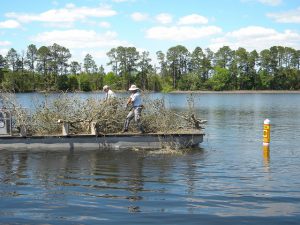October 02, 2013
By Florida Sportsman Newswire
 Photo : www.myfwc.com
Photo : www.myfwc.com
Have you ever been fishing and wished there was a sign saying right where the fish are? Well, fish attractors and the buoys that mark them are intended to do just that.
We all know that sportfish like structure, meaning something different than just a plain sand or mud bottom area, around which to hang out. We also know that tiny plants (phytoplankton) are the food for many bugs that little fish like to eat, and big fish eat little fish.
When biologists plan a fish attractor, they take advantage of those two facts, but a lot more goes into the decision. Research shows attractors may not produce more fish, but they do effectively congregate fish. So fish are more accessible to anglers, especially when there is a lack of natural structure or there is a need to bring fish to a specific location. Translation: a better opportunity to catch fish, from small bream to trophy bass.
For example, in community ponds or small fish management areas that are popular with children and families, it is often desirable to place an attractor near shore or a fishing pier to give young anglers and others without access to a boat somewhere to aim their cast. In other instances, productive lakes may have large areas of open water, and a properly deployed and marked attractor can help provide a new “honey hole” for recreational fishermen.
Before we detail how attractors are constructed, where to find them and how to fish them, let us share a legal disclaimer or two. The Florida Fish and Wildlife Conservation Commission (FWC) has a permit from the Department of Environmental Regulation to place attractors in state waters. It is illegal for anyone to place materials in public waterways without such a permit and, moreover, in many instances it can constitute littering and result in severe penalties. Finally, unmarked attractors without a minimum clearance of 3 feet can become a navigation hazard.
Most FWC-constructed freshwater fish attractors are built from hardwood trees and branches. A suitable location is idenitified that will benefit anglers, and a brushpile is submerged using cinder blocks. Care is taken to keep the tops of the material at least 3 feet below the surface, and a marker buoy is deployed. Hardwood attractors are effective because the natural substrate quickly attracts algae and stimulates the food chain. In addition, passages between the branches provide hiding places for small fish to avoid predators. Ironically, branches also provide concealment points for ambush predators like bass.
Other attractors are made of plastic or concrete materials. Those are normally located away from boat paths. Their advantage is they are longer lasting than hardwood and need to be refurbished less frequently. Other attractors are actually bedding sites. These use oyster shell or gravel to create a desirable area for bass, bream and crappie to spawn over when the surrounding bottom is mucky.They can be very productive for anglers, especially in spring.
The net effect is a community of fish hanging out where anglers can find them. To fish effectively around a fish attractor, there are several considerations. First, use weedless lures or natural baits with strong braided line. Second, when fishing from a boat, do not anchor too close; stay 50 feet or so away and cast toward the buoy. Remember there are branches or other material under the surface, anchoring in amongst them can pull the attractors apart, ruining their effectiveness or fouling your prop.
Most freshwater sport fishes in Florida will use attractors. The FWC's Big Catch program includes 33 different species for which anglers can be recognized. Simply take a photo of the fish and submit it. If the fish is longer than the Big Catch minimum length or weight (see MyFWC.com/BigCatch for details), you will receive a customized certificate and have your picture posted on the Web. There are special sizes for youths under 16 to encourage their participation
However, the big rewards go to TrophyCatch anglers who catch, document and release bass over 8 pounds. Beginning Oct. 1, you just need to submit a photo of your 8-pound plus bass on a scale showing the entire fish and its weight to TrophyCatchFlorida.com. An additional photo showing the length of the fish on a measuring tape will help with verification, if the first photo isn't clear. You can choose to submit other photos such as you holding the fish, the bass' girth and release. In return, you'll receive rewards starting with a $50 Bass Pro Shops gift card and Bass King T-shirt, to go along with your customized certificate and window decal. Registering on the website makes you eligible for a Phoenix Bass Boat drawing. Like us at FaceBook.com/TrophyCatchFlorida to get the latest updates.
Find the location of FWC fish attractors online at MyFWC.com/Fishing (select freshwater, sites and forecasts and then fish attractors). A new map (bit.ly/Attractors) makes it easier for anglers to find attractors and check out the video at bit.ly/YT-attractor.

